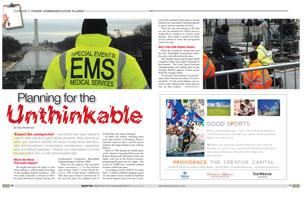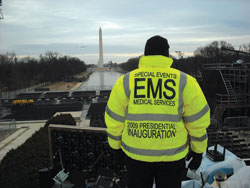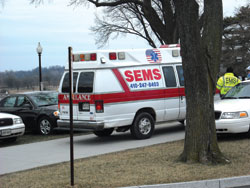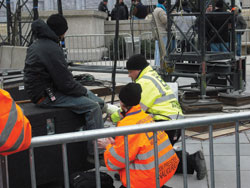
'Expect the unexpected' - truer words were never uttered to a sports event planner or sports facility personnel.
When planning an event, your standard checklist will always include venue selections, hotel accommodations, transportation considerations, registration costs and staffing imperatives. However, you might neglect to include the most critical item: a crisis communication plan.
What's the Worst That Could Happen?
We might anticipate the injury to one of the athletes, a staff member becoming ill and needing medical assistance. But who really expected a tornado to blow through downtown Atlanta during the Southeastern Conference Basketball Championships in March, 2008?
 What are the chances that an earthquake measuring 7.1 on the Richter scale before Game 3 of the World Series in 1989 would shake Candlestick Park and cause massive destruction in the area but spare the ballpark and its 62,000 fans any major damage.
What are the chances that an earthquake measuring 7.1 on the Richter scale before Game 3 of the World Series in 1989 would shake Candlestick Park and cause massive destruction in the area but spare the ballpark and its 62,000 fans any major damage.
In 2000, two fathers watching their sons play hockey in Reading, Massachusetts came to blows and the brawl ended in the tragic death of one of those fathers.
Back in 1988 during the fourth game of the Stanley Cup playoff between the Boston Bruins and Edmonton Oilers the lights went out in the Boston Garden, postponing the game for two nights. The crowd of 14,000 was evacuated without incident within one hour.
According to SAFE KIDS USA more than 3.5 million children ranging in ages 14 and under receive medical treatment for sports injuries each year and 21 percent of all traumatic brain injuries among children are associated with participation in sports and recreational activities.
There are just some things in life that we can't be prepared for which can be a tough pill to swallow as a sports event planner. But a plan of action can make all the difference when the unexpected comes our way.
Don't Fool With Mother Nature
When the tornado hit Atlanta last year the SEC Basketball Tournament wasn't the only event affected in the area.
The Georgia Dome and Georgia World Congress Center were right in the path of the tornado. The Cheer Sport National Championships were taking place at the Georgia World Congress Center across from the Georgia Dome.
"Everyone's first reaction is to get out," said Adam Thomas, president of Universal Spirit. "As the event planner, you revert to your contact at the venue and you rely on that contact and follow their policies and procedures."
Over at the Georgia Dome that evening's SEC Championship game was completed but SEC officials postponed the fourth game until the next morning and moved locations to the Alexander Memorial Coliseum at Georgia Tech.
"The biggest challenge we ever had was producing the SEC basketball tournament," said Jimmy Raybun, vice president of operation with Raycom Sports, which was broadcasting the tournament. "I can't say we planned for that."
"We moved the entire broadcast at 2 a.m. from the Georgia Dome over to Georgia Tech in less than 20 hours," explained Raybun. "Incredible feat on our incredible staff. By the time it was packed up and ready to go - it was 4 a.m. - where do you get a truck driver at 4 a.m.?"
Under normal circumstances, Raycom will enter an arena or facility on a Tuesday morning for a Thursday evening game. "Several things were in our favor," said Raybun. "We also broadcast ACC games and we were familiar with the arena and we had our best people on staff."
Dollars and Sense
Budgets are adhered to and costs kept down when planning your event. But the safety of the athletes and spectators must also be a top priority.
"A lot of event planners don't think about this until the last minute or when it's really needed," said Mike Butler, vice president of Special Events Medical Services in Baltimore, Maryland. "When a planner goes to do their event and when budgets get tight, they will cut emergency services before they cut catering. They are really rolling the dice hoping that something doesn't happen."
Special Events Medical Services is part of an emerging field in events,handling events from a 50-person 5K run/walk to most recently the Presidential Inauguration at Lincoln Memorial. Out of necessity, companies like these are popping up all over the country.
 "Medicine is a field of specialty and specialty gives you better care. We're seeing that in the EMS field as well," said Clay Richmond, the president & CEO of Special Events Medical Services. "We start to focus and apply scientific methodology to take care of mass events.
"Medicine is a field of specialty and specialty gives you better care. We're seeing that in the EMS field as well," said Clay Richmond, the president & CEO of Special Events Medical Services. "We start to focus and apply scientific methodology to take care of mass events.
Their services range from providing the medical staff and supplies needed for an event but coordinating all logistics of your event for a crisis to include staging of the equipment, staff and personnel.
"Each event has its own nuances that must be accounted for," said Richmond. "It's something we always think about and we always have a plan in place."
Costs associated with hired EMS services range from $400 for a smaller event up to $50,000 for an event on a grand scale. The same can be said for communication, with NEXTEL radio rentals averaging $15 per radio and two-way radios ranging from $10 to $25 per unit depending on the scope of the equipment.
But often times, there are questions of the value of these services. You may be asking, 'Why pay for something that we have never needed in the past or why should I pay for something I never intend to use?'
Just one incident can change not only the policies and procedures of your event but also how your event is publicly viewed and managed in the future.
The Missouri Valley Conference can attest to that. During a tournament basketball game in March 2006, Kristi Yamaoka fell 15 feet and landed on her head in front of a crowd of 14,000, resulting in a concussion, spinal fracture and bruised lung. The incident drew national attention from ESPN, the Today show and the Ellen DeGeneres show.
"The accident certainly got our attention," said Patty Viverito, senior associate commissioner of the Missouri Valley Conference. "It could have been catastrophic. We are thankful that it wasn't more serious than it was. But we were also blessed that we had the opportunity to change business, not because something catastrophic happened, but because we were scared."
The Missouri Valley Conference brought in what she refers to as their guardian angel, Bill Boggs of the National Cheerleaders Association. Guidelines were revisited and re-written to be more stringent.
There is now a program in place to provide a staff member to oversee tournaments and events available to all universities from the National Cheerleaders Association.
Uncommon Patients
The most common patients aren't usually the competitors themselves, yet many event planners anticipate only athletic-related medical needs and are unprepared for spectator injury.
"You have more medical problems with spectators than people participating in the sport," said Richmond. "With the crowd, we don't know pre-existing conditions, hazards in the stands, humidity or spills. There are more factors working on the crowd than with the athlete. With the spectators, myriad things can happen in a crowd."
With equestrian events, consideration must be given not only to the riders but the horses as well and that takes on a whole new element in event planning.
HEART or Humane Equine Aid and Rapid Transport is an equine ambulance service that provides emergency care for horses. "The employees are all well versed in trauma care and they have state-of-the-art emergency trailers for the horses," said Jennifer Wood, account executive for Phelps Media Group for the Charlotte Jumper Classic. "If the horses are injured or sick with colic they can be transported to a clinic for surgery. They are on-site 24 hours a day."
Smaller equestrian events like the Charlotte Jumper Classic with 150 horses showing maintain one official veterinarian on-site during competition, but larger events with over 2,000 horses setup a clinic on-site with anywhere from 10-12 veterinarians on call at all times. Some exhibitors choose to bring their own veterinarian with them during the show.
We Interrupt this Broadcast
Power outages and weather can wreak havoc on a live broadcast for any sporting event, but unfortunately, they do happen.
On January 20, 2009 the first 15 minutes of televised broadcast of the Maryland versus Virginia game was not aired due to failure of the systems transporter uplink and redundancy system at Raycom. "The uplink and redundancy just died and nothing worked," explained Raybun. "It was obvious that it wouldn't work an hour before air."
 What should have taken moments to re-route Raycom's feed to Comcast in Atlanta took longer. Satellites were busy with the impending Presidential Inauguration the following day. Fortunately, Raycom was running a split schedule and was able to feed the stations with the other game until the re-route was complete and the game was televised.
What should have taken moments to re-route Raycom's feed to Comcast in Atlanta took longer. Satellites were busy with the impending Presidential Inauguration the following day. Fortunately, Raycom was running a split schedule and was able to feed the stations with the other game until the re-route was complete and the game was televised.
The Los Angeles Sports Council hosts a dinner and live broadcast during their Annual Los Angeles Sports Awards show at an area hotel each year. During one of their events, David Simon, president of the Los Angeles Sports Council was notified that due to an electrical problem, the entire facility would be going dark until after midnight.
"The emcee announced the power outage to the guests and we got the show started immediately," said Simon. "We did the show without any breaks and they blitzed through the entire show by 9:30 p.m. The impending outage added urgency and excitement to the show. The power went out at 10:00 p.m."
Simon discovered at the conclusion of the event that the hotel negotiated with the power company on their behalf to delay the necessary work until after the broadcast was complete.
Working with your venue should always be part of the plan.
The Unthinkable
Recently, a crisis struck an event and was not outlined in any crisis plan. Following a performance at the Universal Spirit National Cheer & Dance Championship in Charlotte, North Carolina a mother of one of the competitors had to break the news that her father had suddenly passed away. None of the staff was truly prepared to deliver such heartbreaking news.
"I learned that we need to have a chaplain at all events moving forward," said Thomas. "We are not trained to handle situations like that. I was so emotional for this little girl." Thomas promptly spoke with a pastor and has incorporated a role within the competition for a chaplain to help staff the event as well as be there in case of an emergency.
Organizers also need to not only have a plan in place internally to handle lost children at events, but to also communicate that information effectively to the parents.
"We have always had a plan in place, but the parents never knew what the plan was. We were worried about opening the flood gates. But we work closely with each facility and have a secure and safe location for lost children that is staffed so that parents can come and get their child," said Thomas. "It may not be a crisis on a global level, but it is a crisis to that family or individual."
What to Do
Many crisis communication plans are available on the Internet with several templates and guidelines that can be customized to fit any event. But the basics ring true for events of all sizes.
The number-one rule is to remain calm and keep others calm followed by coordinating internal communication and maintaining perspective. Communicating properly to the fans and spectators is imperative as well.
"Operationally, there are the hurdles you have to go through," said Thomas. "If you don't have Plan B, you create Plan C real quick."
Yes, there are just some things in life that we aren't always prepared for, but a crisis communication plan can certainly help pave the way for if or when it happens.

